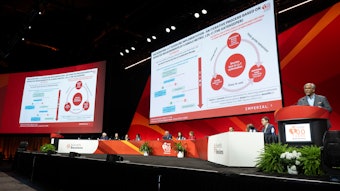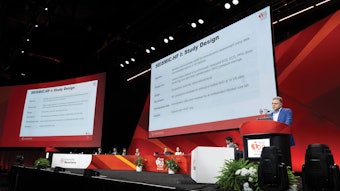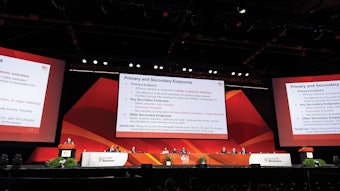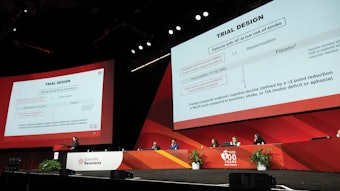LBS coverage | Trials’ results suggest advancements in treatment approaches for CKD/T2D, TIA/minor ischemic stroke, pericarditis and ACS

Investigators in four trials revealed findings to impact treatment of patients with chronic kidney disease/Type 2 diabetes, TIA or minor ischemic stroke, pericarditis and ACS during their Late-Breaking Science session “Randomized Trials: Brain, Kidney and Heart” on Monday. They found:
- The novel investigational agent finerenone reduced the risk of both cardiovascular death and hospitalization for heart failure events in patients with chronic kidney disease and Type 2 diabetes by 14% compared to placebo.
- Ticagrelor, a potent, rapid-acting antiplatelet agent, in addition to aspirin, reduced the risk of subsequent stroke or death at 30 days in patients with minor acute ischemic stroke or high-risk transient ischemic attack with atherosclerotic stenosis.
- Rilonacept, an IL-1α blocker, holds promise for the treatment of pericarditis.
- Rapid coronary CT angiography (CTCA) in intermediate or high-risk patients for ACS did not affect overall treatment and prevention.
Mineralocorticoid receptor antagonist reduced the risk of CV events in patients with chronic kidney disease and Type 2 diabetes
Finerenone, a novel, nonsteroidal, selective mineralocorticoid receptor antagonist (MRA), significantly lowered the overall risk of cardiovascular events in patients with chronic kidney disease and Type 2 diabetes compared to placebo, according to Efficacy and Safety of Finerenone in Subjects With Type 2 Diabetes Mellitus and Diabetic Kidney Disease trial (FIDELIO-DKD).
The randomized, double-blind, placebo-controlled, parallel group multicenter event-driven Phase 3 study enrolled 5,734 patients with Type 2 diabetes and diabetic kidney disease. Patients were randomized to 10 mg or 20 mg finerenone or matching placebo orally once daily. Over a median follow-up of 2.6 years, finerenone met study primary and key secondary endpoints with relative risk reductions of 18% and 14%, respectively, for kidney failure, sustained ≥40% decrease in eGFR from baseline, or renal death (HR= 0.82; 95% confidence interval 0.73-0.93. p=0.0014) and the composite cardiovascular endpoint of time to cardiovascular death, nonfatal myocardial infarction, nonfatal stroke or hospitalization for heart failure (HR=0.86; 95% confidence interval 0.75-0.99; p=0.034), compared to placebo in patients with chronic kidney disease and Type 2 diabetes.
The effects of finerenone on the cardiovascular composite endpoint were consistent in patients with and without a history of cardiovascular disease at baseline, indicating that finerenone provided both primary and secondary prevention of cardiovascular events. The safety profile of finerenone was similar in both groups of patients, with manageable increases in serum potassium and low incidence of hyperkalemia.
“The positive results from this trial suggest that finerenone could provide a novel treatment option for patients with chronic kidney disease and Type 2 diabetes, both to reduce their risk of kidney disease progression and their risk of cardiovascular morbidity and mortality,” said Gerasimos Filippatos, MD, director of the heart failure unit at the Attikon Hospital in Athens, Greece, and the study’s principal investigator. The trial analysis was simultaneously published online in Circulation.
Ticagrelor, added to aspirin therapy, reduced risk of subsequent stroke or death
Ticagrelor, a potent, rapid-acting antiplatelet agent (P2Y12 inhibitor), when added to aspirin in patients with TIA or minor ischemic stroke, reduced the risk of subsequent stroke or death, according to the study Ticagrelor Added to Aspirin in Acute Ischemic Stroke or TIA of Atherosclerotic Origin.
The study, a subanalysis of the Acute STroke or Transient IscHaemic Attack Treated With TicAgreLor and ASA for PrEvention of Stroke and Death (THALES) trial, evaluated ticagrelor added to aspirin in 11,016 patients with TIA or minor ischemic stroke to prevent subsequent stroke or death at 30 days. Patients were randomized within 24 hours of symptom onset.
“In patients with TIA and minor stroke due to atherosclerotic disease, we found a higher absolute risk of subsequent stroke or death at 30 days, and a greater absolute risk reduction on ticagrelor added to aspirin compared to aspirin alone than in patients whose cause of stroke was not atherosclerotic disease,” said Pierre Amarenco, MD, professor and chair at Paris University in France, and the study’s principal investigator.
Dr. Amarenco noted that these findings concur with previous findings in a similar population of TIA or minor ischemic stroke in the SOCRATES trial, which compared ticagrelor alone to aspirin alone, with a significant interaction, an NNT of 35 and NNH of 775.
“Taken together with similar analysis in the SOCRATES trial in patients whose cause of stroke was atherosclerotic disease showing significant interaction, ticagrelor plus aspirin provided a clinically meaningful benefit,” Dr. Amarenco said. “In this easily identified population, patients with TIA or minor stroke of atherosclerotic disease origin indisputably form a group to target for the combination of ticagrelor and aspirin in preventing subsequent stroke or death.”
Rilonacept safely reduced symptom recurrence in patients with pericarditis
Rilonacept, an IL-1α and IL-1β cytokine trap, was effective in resolving pericarditis episodes and in preventing subsequent pericarditis episodes, thus improving the quality of life in patients with recurrent pericarditis, according to RHAPSODY: Rilonacept An IL-1α and IL-1β Trap Resolves Pericarditis Episodes And Reduces Risk Of Recurrence in A Phase 3 Trial Of Patients With Recurrent Pericarditis.
This study was a phase 3, global, multicenter, double-blind, placebo-controlled, randomized withdrawal study. The primary endpoint of efficacy was time to first pericarditis recurrence with safety parameters of rilonacept also assessed. A total of 86 subjects with recurrent pericarditis (average history of 4.4 episodes/year), presented at enrollment with a documented acute pericarditis episode despite standard of care (NSAIDS, colchicine and/or prednisone).
During the run-in period, patients initiated weekly rilonacept and tapered and discontinued background therapy over the subsequent 10 weeks. Clinical responders on monotherapy rilonacept (n=61) were then randomized to rilonacept or placebo in the randomized withdrawal period.
“During the run-in period with rilonacept, we noticed a rapid and sustained response in patients’ report of pain. Pain decreased quickly, as did c-reactive protein (CRP), a marker of inflammation, as early as after the first dose,” said Allan Klein, MD, director of the Center for the Diagnosis and Treatment of Pericardial Diseases at Cleveland Clinic. Importantly, rilonacept allowed steroid tapering and discontinuation.
The primary endpoint was the time to recurrence of pericarditis, and 25 events were accrued in the event-driven randomized withdrawal period. Rilonacept reduced the risk of pericarditis recurrence by 96% (HR=0.04, p<0.0001). In the placebo arm, there were 23 recurrences, and median time to first symptom recurrence was 8.6 weeks in the placebo group. In the rilonacept arm, the time to recurrence could not be calculated because there were too few events. Only two patients experienced recurrence, and both were associated with temporary study drug interruptions of one and three weeks. The safety profile was consistent with the known safety profile of rilonacept.
Overall, in this patient population of recurrent pericarditis, rilonacept provided rapid response of pericarditis episodes and prevention of subsequent episodes while on treatment. “Rilonacept offers a rapid and sustained clinical response and prevents recurrence,” Dr. Klein said. “This IL-1α and IL-1β trap could be a game-changer paradigm shift that could offer a new precision therapy option. If these patients could start rilonacept earlier, we may be able to control this disease just using a single drug, allowing patients to avoid the negative effects of steroids.” Further data are expected from the ongoing long-term extension study (up to 24 months). Trial results were simultaneously published in The New England Journal of Medicine.
Rapid coronary CT angiography did not change outcomes in patients with suspected ACS
The performance of early coronary CT angiography (CTCA) demonstrated not to benefit intermediate or higher risk patients with suspected or provisionally diagnosed acute coronary syndrome who present to the emergency department, according to Rapid Assessment of Potential Ischemic Heart Disease with Early Coronary CT Angiography (RAPID-CTCA) trial.
The prospective, randomized, open-blinded endpoint parallel-group clinical trial enrolled 1,748 patients with suspected or provisionally diagnosed acute coronary syndrome presenting to the emergency department in 37 centers across the U.K. Participants were randomized to CTCA with standard of care or standard of care alone. Patients with STEMI, NSTEMI with hemodynamic instability, heart failure, arrhythmia, highly confirmative or dynamic ECG changes, or when the treating clinician believed early invasive angiography was required, were excluded from the trial.
Overall, there was no difference in the primary outcome of all-cause death or subsequent type 1 (spontaneous) or type 4B (stent thrombosis) myocardial infarction at one year. However, early CTCA did increase patient satisfaction, diagnostic certainty and reduced the need for invasive coronary angiography without affecting rates of coronary revascularization.
“Early CTCA in intermediate or high-risk patients presenting to the emergency department with suspected or provisionally diagnosed acute coronary syndrome has no effect on the overall treatment and prevention of acute coronary syndromes or one-year outcomes and is associated with a modest increase in length of hospital stay and health care costs,” said Alastair J. Gray, University of Edinburgh in Scotland, the study’s chief investigator.
Trials show glucose-lowering drug may help manage heart failure in patients with Type 2 diabetes and kidney disease
Sotagliflozin, a dual SGLT1 and SGLT2 inhibitor, significantly reduced cardiovascular deaths, hospitalizations for heart failure and urgent heart failure in patients with type 2 diabetes with heart failure, according to Effect of Sotagliflozin on Cardiovascular Events in Patients With Type 2 Diabetes Post Worsening Heart Failure, the SOLOIST-WHF trial.
The phase 3, multicenter, double-blind trial randomized 1,222 male and female patients with Type 2 diabetes and recent hospitalization for decompensated heart failure to sotagliflozin or placebo. Key inclusion criteria included type 2 diabetes, hospital admission with signs and symptoms of heart failure and treatment with intravenous diuretics. Patients were stabilized, had a systolic BP ≥ 100, off oxygen and transitioning to oral diuretics with BNP ≥150 pg/mL (≥450 pg/mL if atrial fibrillation) or NT-proBNP ≥600 pg/mL (≥1800 pg/mL if atrial fibrillation).
Sotagliflozin is an SGLT2 inhibitor that also inhibits gastrointestinal SGLT1. Inhibition of SGLT2 increases urinary glucose excretion, whereas inhibition of SGLT1 appears to delay glucose absorption and reduce postprandial glucose.
Overall, sotagliflozin benefited patients compared to the placebo. “Sotagliflozin significantly reduced the composite of total cardiovascular deaths, hospitalizations for heart failure, and urgent heart failure visits by 33%, with an early benefit that was significant by one month and a number needed to treat of only four patient-years,” said Deepak L. Bhatt, MD, MPH, executive director of Interventional Cardiovascular Programs at Brigham and Women's Hospital Heart & Vascular Center, and the study’s principal investigator.
The benefits were consistent across subgroups, including initiation prior to or soon after hospital discharge and in heart failure with reduced or preserved ejection fraction, Dr. Bhatt said.
Sotagliflozin may also help prevent cardiovascular events in patients with Type 2 diabetes and chronic kidney disease, according to the Effect of Sotagliflozin on Cardiovascular and Renal Events in Patients With Type 2 Diabetes and Moderate Renal Impairment Who Are at Cardiovascular Risk, the SCORED trial.
The phase 3, multicenter, double-blind trial randomized 10,584 patients with type 2 diabetes, cardiovascular risk factors, and moderately to severely impaired renal function (estimated glomerular filtration rate of 25-60 ml per minute per 1.73 m2 of body surface area) to sotagliflozin or placebo.
Overall, in patients with Type 2 diabetes and chronic kidney disease, “sotagliflozin significantly reduced the composite of total cardiovascular deaths, hospitalizations for heart failure, and urgent heart failure visits by 26%, with an early benefit that was significant by three months,” said Dr. Bhatt.
Total cardiovascular deaths, non-fatal myocardial infarctions, and non-fatal strokes were reduced by 23%, Dr. Bhatt said. The benefits of sotagliflozin were consistent across subgroups, including patients with macro- and micro-albuminuria and with heart failure with reduced or preserved ejection fraction.
Pooled SOLOIST and SCORED data indicate that with careful patient selection and monitoring, “SGLT2/1 inhibitors should be strongly considered in the majority of patients with Type 2 diabetes including those admitted with acute decompensated heart failure, heart failure with either reduced or preserved ejection fraction, with chronic kidney disease across the full range of proteinuria,” Dr. Bhatt said.
“Unlike pure SGLT2, the SGLT1 inhibition from sotagliflozin provided glycemic control even at the lower range of estimated glomerular filtration rate. The lower rate of myocardial infarction and stroke with sotagliflozin suggests an additional relatively early anti-atherosclerotic effect of SGLT1 inhibition which should be explored further.” SOLOIST and SCORED trials were ended early due to loss of funding from the sponsor during the COVID-19 pandemic. In both trials, with careful patient selection, sotagliflozin was generally safe and well tolerated.











